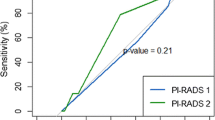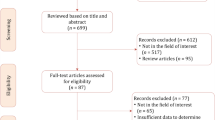Abstract
Objectives
The Prostate Imaging for Recurrence Reporting (PI-RR) system has been recently proposed to promote standardisation in the MR assessment of prostate cancer (PCa) local recurrence after radical prostatectomy (RP) and radiation therapy (RT). This study aims to evaluate PI-RR’s diagnostic accuracy, assess the inter-observer reliability among readers with variable experience, and correlate imaging results with anatomopathological and laboratory parameters.
Methods
Patients who underwent a pelvic MRI for suspicion of PCa local recurrence after RP or RT were retrospectively enrolled (October 2017–February 2020). PI-RR scores were independently assessed for each patient by five readers with variable experience in prostate MRI (two senior and three junior radiologists). Biochemical data and histopathological features were collected. The reference standard was determined through biochemical, imaging, or histopathological follow-up data. Reader’s diagnostic performance was assessed using contingency tables. Cohen’s kappa coefficient (κ) and intraclass correlation coefficient (ICC) were calculated to measure inter-observer reliability.
Results
The final cohort included 120 patients (median age, 72 years [IQR, 62–82]). Recurrence was confirmed in 106 (88.3%) patients. Considering a PI-RR score ≥ 3 as positive for recurrence, minimum and maximum diagnostic values among the readers were as follows: sensitivity 79–86%; specificity 64–86%; positive predictive value 95–98%; negative predictive value 33–46%; accuracy 79–87%. Regardless of reader’s level of experience, the inter-observer reliability resulted good or excellent (κ ranges across all readers: 0.52–0.77), and ICC was 0.8. Prostate-specific antigen (PSA) velocity, baseline-PSA, and trigger-PSA resulted predictive of local recurrence at imaging.
Conclusions
The PI-RR system is an effective tool for MRI evaluation of PCa local recurrence and facilitates uniformity among radiologists.
Clinical relevance statement
This study confirmed the PI-RR system’s good diagnostic accuracy for the MRI evaluation of PCa local recurrences. It showed high reproducibility among readers with variable experience levels, validating it as a promising standardisation tool for assessing patients with biochemical recurrence.
Key Points
• In this retrospective study, the PI-RR system revealed promising diagnostic performances among five readers with different experience (sensitivity 79–86%; specificity 64–86%; accuracy 79–87%).
• The inter-observer reliability among the five readers resulted good or excellent (κ ranges: 0.52–0.77) with an intraclass correlation coefficient of 0.8.
• The PI-RR assessment score may facilitate standardisation and generalizability in the evaluation of prostate cancer local recurrence among radiologists.






Similar content being viewed by others
Abbreviations
- BCR:
-
Biochemical recurrence
- CT:
-
Computed tomography
- DCE:
-
Dynamic contrast enhancement
- DWI:
-
Diffusion-weighted imaging
- EAU:
-
European Association of Urology
- GRE:
-
Gradient recalled echo
- GS:
-
Gleason score
- ICC:
-
Intraclass correlation coefficient
- IQR:
-
Interquartile range
- ISUP:
-
International Society of Urological Pathology
- MRI:
-
Magnetic resonance imaging
- NPV:
-
Negative predictive value
- PCa:
-
Prostate cancer
- PET:
-
Positron emission tomography
- PI-RADS:
-
Prostate Imaging-Reporting and Data System
- PI-RR:
-
Prostate Imaging for Recurrence Reporting
- PPV:
-
Positive predictive value
- PSA:
-
Prostate-specific antigen
- PSADT:
-
Prostate-specific antigen doubling time
- PSAV:
-
Prostate-specific antigen velocity
- PSMA:
-
Prostate-specific membrane antigen
- RP:
-
Radical prostatectomy
- RT:
-
Radiation therapy
- SRT:
-
Salvage radiotherapy
- T2WI:
-
T2-weighted imaging
- TE:
-
Time of echo
- TR:
-
Repetition time
- TSE:
-
Turbo spin-echo
References
Pernar CH, Ebot EM, Wilson KM, Mucci LA (2018) The epidemiology of prostate cancer. Cold Spring Harb Perspect Med 8:a030361. https://doi.org/10.1101/cshperspect.a030361
Mottet N, van den Bergh RCN, Briers E et al (2021) EAU-EANM-ESTRO-ESUR-SIOG Guidelines on prostate cancer—2020 update. Part 1: screening, diagnosis, and local treatment with curative intent. Eur Urol 79:243–262. https://doi.org/10.1016/j.eururo.2020.09.042
Mottet N, Cornford P, van den Bergh RCN et al (2022) EAU guidelines: prostate cancer. Edn. presented at the EAU Annual Congress Amsterdam 2022. EAU Guidelines Office, Arnhem, The Netherlands. https://uroweb.org/guidelines/prostate-cancer. Accessed 13 Aug 2022
Artibani W, Porcaro AB, De Marco V, Cerruto MA, Siracusano S (2018) Management of biochemical recurrence after primary curative treatment for prostate cancer: a review. Urol Int 100:251–262. https://doi.org/10.1159/000481438
Roach M, Hanks G, Thames H et al (2006) Defining biochemical failure following radiotherapy with or without hormonal therapy in men with clinically localised prostate cancer: recommendations of the RTOG-ASTRO Phoenix Consensus Conference. Int J Radiat Oncol Biol Phys 65:965–974. https://doi.org/10.1016/j.ijrobp.2006.04.029
Lowrance WT, Breau RH, Chou R et al (2021) Advanced prostate cancer: AUA/ASTRO/SUO guideline PART I. J Urol 205:14–21. https://doi.org/10.1097/JU.0000000000001375
Zaorsky NG, Calais J, Fanti S et al (2021) Salvage therapy for prostate cancer after radical prostatectomy. Nat Rev Urol 18:643–668. https://doi.org/10.1038/s41585-021-00497-7
Marra G, Valerio M, Emberton M et al (2019) Salvage local treatments after focal therapy for prostate cancer. Eur Urol Oncol 2:526–538. https://doi.org/10.1016/j.euo.2019.03.008
Cornford P, van den Bergh RCN, Briers E et al (2021) EAU-EANM-ESTRO-ESUR-SIOG Guidelines on prostate cancer. Part II—2020 update: treatment of relapsing and metastatic prostate cancer. Eur Urol 79:263–282. https://doi.org/10.1016/j.eururo.2020.09.046
Créhange G, Roach M, Martin É et al (2014) Salvage reirradiation for locoregional failure after radiation therapy for prostate cancer: who, when, where and how? Cancer Radiother 18:524–534. https://doi.org/10.1016/j.canrad.2014.07.153
De Visschere PJL, Standaert C, Fütterer JJ et al (2019) A systematic review on the role of imaging in early recurrent prostate cancer. Eur Urol Oncol 2:47–76. https://doi.org/10.1016/j.euo.2018.09.010
Parker C, Castro E, Fizazi K et al (2020) Prostate cancer: ESMO Clinical Practice Guidelines for diagnosis, treatment and follow-up. Ann Oncol 31:1119–1134. https://doi.org/10.1016/j.annonc.2020.06.011
Das JP, Woo S (2022) Multiparametric prostate MRI for biochemical failure in the era of targeted PET radiotracers: point—MRI may no longer be needed in patient workup. AJR Am J Roentgenol 16:1–2. https://doi.org/10.2214/AJR.22.27882
Pecoraro M, Panebianco V (2022) Multiparametric prostate MRI for biochemical failure in the era of targeted PET radiotracers: counterpoint—MRI remains a specific and accessible test for targeted management. AJR Am J Roentgenol 16:1–2. https://doi.org/10.2214/AJR.22.28042
Van der Poel H, Grivas N, van Leeuwen P, Heijmink S, Schoots I (2019) The role of MRI for detection and staging of radio- and focal therapy-recurrent prostate cancer. World J Urol 37:1485–1490. https://doi.org/10.1007/s00345-019-02677-y
Potretzke TA, Froemming AT, Gupta RT (2020) Post-treatment prostate MRI. Abdom Radiol (NY) 45:2184–2197. https://doi.org/10.1007/s00261-019-02348-x
Panebianco V, Barchetti F, Sciarra A et al (2013) Prostate cancer recurrence after radical prostatectomy: the role of 3-T diffusion imaging in multiparametric magnetic resonance imaging. Eur Radiol 23:1745–1752. https://doi.org/10.1007/s00330-013-2768-3
Linder B, Kawashima A, Woodrum D et al (2014) Early localisation of recurrent prostate cancer after prostatectomy by endorectal coil magnetic resonance imaging. Can J Urol 21:7283–7289
Odisho AY, Washington SL, Meng MV, Cowan JE, Simko JP, Carroll PR (2013) Benign prostate glandular tissue at radical prostatectomy surgical margins. Urology 82:154–159. https://doi.org/10.1016/j.urology.2012.12.063
Burkhardt O, Neuenschwander JE, John H, Randazzo M (2018) Does seminal vesicle-sparing robotic radical prostatectomy influence postoperative prostate-specific antigen measured with an ultrasensitive immunoassay? Swiss Med Wkly 148:w14685. https://doi.org/10.4414/smw.2018.14685
Panebianco V, Villeirs G, Weinreb JC et al (2021) Prostate Magnetic Resonance Imaging for Local Recurrence Reporting (PI-RR): international consensus -based guidelines on multiparametric magnetic resonance imaging for prostate cancer recurrence after radiation therapy and radical prostatectomy. Eur Urol Oncol 4:868–876. https://doi.org/10.1016/j.euo.2021.01.003
Pecoraro M, Turkbey BI, Purysko AS et al (2022) Diagnostic accuracy and observer agreement of the MRI Prostate Imaging for Recurrence Reporting assessment score. Radiology 304:342–350. https://doi.org/10.1148/radiol.212252
Pound CR, Partin AW, Eisenberger MA, Chan DW, Pearson JD, Walsh PC (1999) Natural history of progression after PSA elevation following radical prostatectomy. JAMA 281:1591. https://doi.org/10.1001/jama.281.17.1591
Vickers AJ, Brewster SF (2012) PSA velocity and doubling time in diagnosis and prognosis of prostate cancer. Br J Med Surg Urol 5:162–168. https://doi.org/10.1016/j.bjmsu.2011.08.006
Connolly D, Black A, Murray LJ, Napolitano G, Gavin A, Keane PF (2007) Methods of calculating prostate-specific antigen velocity. Eur Urol 52:1044–1051. https://doi.org/10.1016/j.eururo.2006.12.017
Epstein JI, Egevad L, Amin MB et al (2016) The 2014 International Society of Urological Pathology (ISUP) consensus conference on Gleason grading of prostatic carcinoma: definition of grading patterns and proposal for a new grading system. Am J Surg Pathol 40:244–252. https://doi.org/10.1097/PAS.0000000000000530
Mottet N, Bellmunt J, Bolla M et al (2017) EAU-ESTRO-SIOG guidelines on prostate cancer. Part 1: screening, diagnosis, and local treatment with curative intent. Eur Urol 71:618–629. https://doi.org/10.1016/j.eururo.2016.08.003
Van den Broeck T, van den Bergh RCN, Arfi N et al (2019) Prognostic value of biochemical recurrence following treatment with curative intent for prostate cancer: a systematic review. Eur Urol 75:967–987. https://doi.org/10.1016/j.eururo.2018.10.011
Tilki D, Preisser F, Graefen M et al (2019) External Validation of the European Association of Urology Biochemical Recurrence risk groups to predict metastasis and mortality after radical prostatectomy in a European cohort. Eur Urol 75:896–900. https://doi.org/10.1016/j.eururo.2019.03.016
Panebianco V, Turkbey B (2023) Magnetic resonance imaging for prostate cancer recurrence: it’s time for precision diagnostic with Prostate Imaging for Recurrence Reporting (PI-RR) score. Eur Radiol 33:748–751. https://doi.org/10.1007/s00330-022-09095-6
Kitajima K, Hartman RP, Froemming AT, Hagen CE, Takahashi N, Kawashima A (2015) Detection of local recurrence of prostate cancer after radical prostatectomy using endorectal coil MRI at 3 T: addition of DWI and dynamic contrast enhancement to T2-weighted MRI. AJR Am J Roentgenol 205:807–816. https://doi.org/10.2214/AJR.14.14275
Sandgren K, Westerlinck P, Jonsson JH et al (2019) Imaging for the detection of locoregional recurrences in biochemical progression after radical prostatectomy—a systematic review. Eur Urol Focus 5:550–560. https://doi.org/10.1016/j.euf.2017.11.001
Haider MA, Chung P, Sweet J et al (2008) Dynamic contrast-enhanced magnetic resonance imaging for localisation of recurrent prostate cancer after external beam radiotherapy. Int J Radiat Oncol Biol Phys 70:425–430. https://doi.org/10.1016/j.ijrobp.2007.06.029
Kim CK, Park BK, Park W, Kim SS (2010) Prostate MR imaging at 3T using a phased-arrayed coil in predicting locally recurrent prostate cancer after radiation therapy: preliminary experience. Abdom Imaging 35:246–252. https://doi.org/10.1007/s00261-008-9495-2
Turkbey B, Rosenkrantz AB, Haider MA et al (2019) Prostate Imaging Reporting and Data System version 2.1: 2019 update of Prostate Imaging Reporting and Data System version 2. Eur Urol 76:340–351. https://doi.org/10.1016/j.eururo.2019.02.033
Morash C (2021) What do you do with PI-RADS-3? Can Urol Assoc J 15:122. https://doi.org/10.5489/cuaj.7262
Kaps B, Leapman M, An Y (2020) Trends in prostatectomy utilization: increasing upfront prostatectomy and postprostatectomy radiotherapy for high-risk prostate cancer. Cancer Med 9:8754–8764. https://doi.org/10.1002/cam4.3482
Cooperberg MR, Carroll PR (2015) Trends in Management for patients with localised prostate cancer, 1990–2013. JAMA 314:80. https://doi.org/10.1001/jama.2015.6036
Funding
The authors state that this work has not received any funding.
Author information
Authors and Affiliations
Corresponding author
Ethics declarations
Guarantor
The scientific guarantor of this publication is María Milagros Otero-García.
Conflict of interest
The authors of this manuscript declare no relationships with any companies, whose products or services may be related to the subject matter of the article.
Statistics and biometry
One of the authors, María Aymerich (Institution: Diagnostic Imaging Research Group, Radiology Department, Galicia Sur Health Research Institute, SERGAS-UVIGO), is an expert in statistics/biometry.
Informed consent
The need for individual consent was waived by the Committee due to the retrospective nature of the study and according to local regulation.
Ethical approval
Institutional Review Board approval was obtained (identification no. 2022/239).
Study subjects or cohorts overlap
No study subjects or cohorts have been previously reported.
Methodology
• Retrospective
• Observational
• Performed at one institution
Additional information
Publisher's Note
Springer Nature remains neutral with regard to jurisdictional claims in published maps and institutional affiliations.
Supplementary Information
Below is the link to the electronic supplementary material.
Rights and permissions
Springer Nature or its licensor (e.g. a society or other partner) holds exclusive rights to this article under a publishing agreement with the author(s) or other rightsholder(s); author self-archiving of the accepted manuscript version of this article is solely governed by the terms of such publishing agreement and applicable law.
About this article
Cite this article
Franco, P.N., Frade-Santos, S., García-Baizán, A. et al. An MRI assessment of prostate cancer local recurrence using the PI-RR system: diagnostic accuracy, inter-observer reliability among readers with variable experience, and correlation with PSA values. Eur Radiol 34, 1790–1803 (2024). https://doi.org/10.1007/s00330-023-09949-7
Received:
Revised:
Accepted:
Published:
Issue Date:
DOI: https://doi.org/10.1007/s00330-023-09949-7




